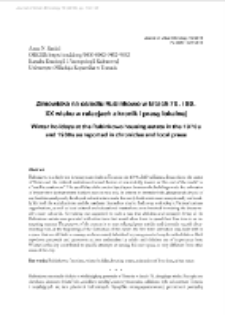- Search in all Repository
- Literature and maps
- Archeology
- Mills database
- Natural sciences
Advanced search
Advanced search
Advanced search
Advanced search
Advanced search

Object
Title: Zimowiska na osiedlu Rubinkowo w latach 70. i 80. XX wieku w relacjach z kronik i prasy lokalnej
Subtitle:
Winter holidays at the Rubinkowo housing estate in the 1970s and 1980s as reported in chronicles and local press ; Journal of Urban Ethnology 16 (2018)
Publisher:
Instytut Archeologii i Etnologii PAN
Place of publishing:
Description:
Type of object:
Abstract:
Rubinkowo is a high-rise housing estate built in Toruń in the 1970s. Self-sufficient, distant from the centre of Toruń and the cultural institutions located therein, it was initially known as “the end of the world” or a “satellite settlement”. The specificity of the undeveloped space between the buildings made the animation of leisure time during winter holidays not an easy task. In winter, its irregular hills, playgrounds devoid of any facilities, and poorly developed infrastructure made the newly built estate seem exceptionally unfriendly. Yet both the social activists and the residents themselves tried to find a way to develop it. Various business organizations, as well as local cultural and educational institutions, were involved in making the dreary reality more colourful. Everything was organised in such a way that children and teenagers living at the Rubinkowo estate were provided with attractions that would allow them to spend their free time in an interesting manner. The purpose of the current is to trace selected press articles and chronicle records documenting how, at the beginning of the formation of the estate, the free-time animation was dealt with in a space that was difficult to manage and was mainly inhabited by young married couples with children. Both top-down proposals and grassroots actions undertaken by adults and children are of importance here. Winter in the city contributed to specific attempts at taming this new space, so very different from other areas of the city
References:
Derek M. 2014, Miejska przestrzeń czasu wolnego, w: M. Madurowicz (red.), Kształtowanie współczesnej przestrzeni miejskiej, Wyd. Uniwersytetu Warszawskiego, Warszawa
Jabłońska B. 2006, Krytyczna analiza dyskursu: refleksje teoretyczno metodologiczne, „Przegląd Socjologii Jakościowej”, t. II, nr 1 – listopad
Jałowiecki B. 2005, Przestrzeń ludyczna, „Studia Regionalne i Lokalne”, nr 3 (21)
Kłoskowska A. 1983, Kultura masowa. Krytyka i obrona, PWN, Warszawa
Lipski A. 2008, Czas wolny w czasie życia. Przyczynek do analizy społeczeństwa nowoczesnego, „Ruch Prawniczy, Ekonomiczny i Socjologiczny”, z. 4
MacCannell D. 2002, Turysta. Nowa teoria klasy próżniaczej, Muza, Warszawa
Martyka A. 2012, Czas wolny dzieci we współczesnych polskich miastach. Wprowadzenie do poszukiwań odpowiednich rozwiązań przestrzennych, „Architektura. Czasopismo Techniczne”, z. 29, 7-A
Synowiec A. 2013, W stronę analizy tekstu – wprowadzenie do teorii dyskursu, „Zeszyty Naukowe Politechniki Śląskiej”, z. 65
Wielicki K. 2011, Rozważania o czasie wolnym, wybrane zagadnienia, Górnośląska Wyższa Szkoła Handlowa im. Wojciecha Korfantego, Katowice
Van Dijk T. 2001, Badania nad dyskursem, PWN, Warszawa
Relation:
Volume:
Start page:
End page:
Detailed Resource Type:
Format:
Resource Identifier:
oai:rcin.org.pl:67905 ; 1429-0618
Source:
IAiE PAN, call no. P 714 ; IAiE PAN, call no. P 1505 ; click here to follow the link
Language:
Rights:
Terms of use:
Copyright-protected material. May be used within the limits of statutory user freedoms
Digitizing institution:
Institute of Archaeology and Ethnology of the Polish Academy of Sciences
Original in:
Library of the Institute of Archaeology and Ethnology of the Polish Academy of Sciences
Access:
Object collections:
- Digital Repository of Scientific Institutes > Partners' collections > Institute of Archeology and Ethnology PAS > Institute Publications
- Digital Repository of Scientific Institutes > Partners' collections > Institute of Archeology and Ethnology PAS > Institute Publications > Current Journals
- Digital Repository of Scientific Institutes > Literature > Journals/Articles
- Digital Repository of Scientific Institutes > Partners' collections > Institute of Archeology and Ethnology PAS > Institute Publications > Current Journals > Journal of Urban Ethnology
Last modified:
Apr 11, 2021
In our library since:
Jan 17, 2019
Number of object content downloads / hits:
221
All available object's versions:
https://rcin.org.pl./publication/88516
Show description in RDF format:
Show description in RDFa format:
Show description in OAI-PMH format:
| Edition name | Date |
|---|---|
| Kmieć, Anna N., 2018, Zimowiska na osiedlu Rubinkowo w latach 70. i 80. XX wieku w relacjach z kronik i prasy lokalnej | Apr 11, 2021 |
Objects Similar
Matysek-Imielińska, Magdalena
Darulová, Jolana
Nowina-Sroczyńska, Ewa
Manikowska, Halina Pomierny-Wąsińska, Anna (1988– )
Pirveli, Marika
Hołda, Renata
Czarnecka, Dominika

 INSTYTUT ARCHEOLOGII I ETNOLOGII POLSKIEJ AKADEMII NAUK
INSTYTUT ARCHEOLOGII I ETNOLOGII POLSKIEJ AKADEMII NAUK
 INSTYTUT BADAŃ LITERACKICH POLSKIEJ AKADEMII NAUK
INSTYTUT BADAŃ LITERACKICH POLSKIEJ AKADEMII NAUK
 INSTYTUT BADAWCZY LEŚNICTWA
INSTYTUT BADAWCZY LEŚNICTWA
 INSTYTUT BIOLOGII DOŚWIADCZALNEJ IM. MARCELEGO NENCKIEGO POLSKIEJ AKADEMII NAUK
INSTYTUT BIOLOGII DOŚWIADCZALNEJ IM. MARCELEGO NENCKIEGO POLSKIEJ AKADEMII NAUK
 INSTYTUT BIOLOGII SSAKÓW POLSKIEJ AKADEMII NAUK
INSTYTUT BIOLOGII SSAKÓW POLSKIEJ AKADEMII NAUK
 INSTYTUT CHEMII FIZYCZNEJ PAN
INSTYTUT CHEMII FIZYCZNEJ PAN
 INSTYTUT CHEMII ORGANICZNEJ PAN
INSTYTUT CHEMII ORGANICZNEJ PAN
 INSTYTUT FILOZOFII I SOCJOLOGII PAN
INSTYTUT FILOZOFII I SOCJOLOGII PAN
 INSTYTUT GEOGRAFII I PRZESTRZENNEGO ZAGOSPODAROWANIA PAN
INSTYTUT GEOGRAFII I PRZESTRZENNEGO ZAGOSPODAROWANIA PAN
 INSTYTUT HISTORII im. TADEUSZA MANTEUFFLA POLSKIEJ AKADEMII NAUK
INSTYTUT HISTORII im. TADEUSZA MANTEUFFLA POLSKIEJ AKADEMII NAUK
 INSTYTUT JĘZYKA POLSKIEGO POLSKIEJ AKADEMII NAUK
INSTYTUT JĘZYKA POLSKIEGO POLSKIEJ AKADEMII NAUK
 INSTYTUT MATEMATYCZNY PAN
INSTYTUT MATEMATYCZNY PAN
 INSTYTUT MEDYCYNY DOŚWIADCZALNEJ I KLINICZNEJ IM.MIROSŁAWA MOSSAKOWSKIEGO POLSKIEJ AKADEMII NAUK
INSTYTUT MEDYCYNY DOŚWIADCZALNEJ I KLINICZNEJ IM.MIROSŁAWA MOSSAKOWSKIEGO POLSKIEJ AKADEMII NAUK
 INSTYTUT PODSTAWOWYCH PROBLEMÓW TECHNIKI PAN
INSTYTUT PODSTAWOWYCH PROBLEMÓW TECHNIKI PAN
 INSTYTUT SLAWISTYKI PAN
INSTYTUT SLAWISTYKI PAN
 SIEĆ BADAWCZA ŁUKASIEWICZ - INSTYTUT TECHNOLOGII MATERIAŁÓW ELEKTRONICZNYCH
SIEĆ BADAWCZA ŁUKASIEWICZ - INSTYTUT TECHNOLOGII MATERIAŁÓW ELEKTRONICZNYCH
 MUZEUM I INSTYTUT ZOOLOGII POLSKIEJ AKADEMII NAUK
MUZEUM I INSTYTUT ZOOLOGII POLSKIEJ AKADEMII NAUK
 INSTYTUT BADAŃ SYSTEMOWYCH PAN
INSTYTUT BADAŃ SYSTEMOWYCH PAN
 INSTYTUT BOTANIKI IM. WŁADYSŁAWA SZAFERA POLSKIEJ AKADEMII NAUK
INSTYTUT BOTANIKI IM. WŁADYSŁAWA SZAFERA POLSKIEJ AKADEMII NAUK




































